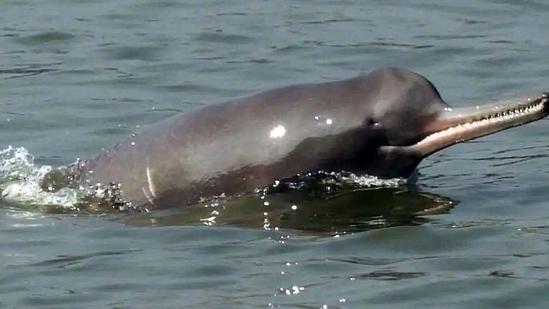Ganges River Dolphin geotagged in Assam: Environment minister
The Ganges dolphin is an indicator species, whose status provides information on the overall condition of the ecosystem and of other species in that ecosystem.
In a first for India, a Ganges River Dolphin has been geotagged in Assam, the environment ministry said on Wednesday.

The news was shared by Union minister of environment, forest and climate change (MoEFCC) Bhupender Yadav on X. “Happy to share the news of the first-ever tagging of Ganges River Dolphin in Assam—a historic milestone for the species and India! This MoEFCC and National CAMPA-funded project, led by the Wildlife Institute of India in collaboration with Assam Forest Dept and Aaranyak, will deepen our understanding of conserving our National Aquatic Animal,” he shared.
According to World Wildlife Fund (WWF), experts from WWF in collaboration with the Sindh Wildlife Department, safely tagged three Indus dolphins in Pakistan with satellite transmitters in January 2022. That was the first time that such technology was used on any of the river dolphin species in Asia.
Under the Project Dolphin launched by the Centre in 2020, the MoEFCC has commissioned Wildlife Institute of India to undertake a comprehensive range-wide research to develop conservation action plan, and fill existing knowledge gaps for the long-term conservation of the species.
The Ganges dolphin is an indicator species, whose status provides information on the overall condition of the ecosystem and of other species in that ecosystem, for the Ganga ecosystem and is extremely vulnerable to changes in water quality and flow. It is categorised as endangered on the International Union for the Conservation of Nature Red List.
An assessment done by WWF India and the Uttar Pradesh forest department in 2012 and 2015 recorded 1,272 dolphins in the Ganga, Yamuna, Chambal, Ken, Betwa, Son, Sharda, Geruwa, Gahagra, Gandak and Rapti.
The Project will involve conservation of Dolphins and the aquatic habitat through use of modern technology specially in enumeration and anti-poaching activities. The project will engage the fishermen and other river/ ocean dependent population and will strive for improving the livelihood of the local communities, MoEFCC had said.
In 2022, the Union environment ministry designated October 5 as the National Dolphin Day, to be celebrated annually . The decision to designate a National Dolphin Day was taken by the standing committee of the National Board for Wildlife (NBWL).
“Healthy aquatic ecosystems help in maintaining the overall health of the Planet. Dolphins act as ideal ecological indicators of a healthy aquatic ecosystem and conservation of the dolphins will, therefore, benefit the survival of the species and also, the people dependent on the aquatic system for their livelihood. The Ministry has been taking up several activities for the protection and conservation of Dolphins and its habitats. Considering that generating awareness among people on the benefits of conservation of dolphins and participation of people in conservation efforts is imperative, the standing committee recommended that every year 5th of October shall be celebrated as National Dolphin Day,” an environment ministry statement had said.
The Ganges River Dolphin is unique in its ecology, being nearly blind and relying on echolocation for its biological needs. Approximately 90% of the species’ population resides in India, historically distributed across the Ganga-Brahmaputra-Meghna and Karnaphuli river systems. However, its distribution has drastically declined over the past century. Despite its wide range, significant knowledge gaps remain regarding this species due to its elusive behaviour; it surfaces for only 5-30 seconds at a time, posing a significant challenge in understanding the ecological needs of the species and for any scientifically sound conservation interventions, scientists involved in the project said.
“Given that Ganges river dolphins are apex predators, and serve as umbrella species for the river systems, it is important to ensure their well-being, as it will ensure of the sustenance of the entire river ecosystem. Given the paucity of information on Ganges river dolphin habitat needs, movement pattern or home range information, it was decided to undertake satellite tagging of dolphins in it’s distribution range. The first of the tagging took place in Assam, where a healthy male river dolphin was tagged and released under utmost veterinary care,” MoEFCC said in a statement.
The tagging exercise will help in understanding their seasonal and migratory patterns, range, distribution, and habitat utilisation, particularly in fragmented or disturbed river systems.
“Tagging river dolphins will contribute to evidence-based conservation strategies that are urgently needed for this species. I am delighted that this historic step has been undertaken,” WII director Virendra R Tiwari said.
Project investigator Vishnupriya Kolipakam emphasised, “This is a significant advancement in understanding the ecological needs of river dolphins, which will help conserve critical habitats within these vast river ecosystems. This is vital not only for aquatic biodiversity but also for sustaining thousands of people who depend on these resources.”






